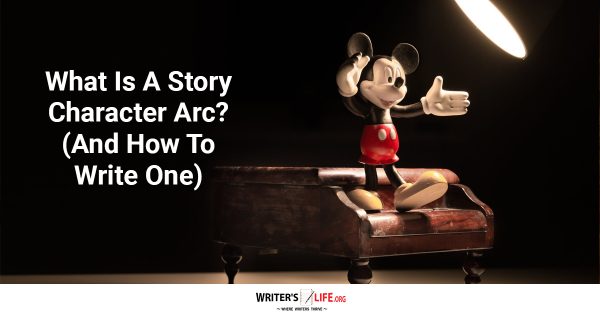- How To Tackle Jealousy In Creative Writing
- Common Submission Mistakes
- How To Stop Your Blog Becoming Boring
- The One Thing Every Successful Writer Has In Common
- How To Make Yourself Aware Of Publishing Scams
- Why Almost ALL Writers Make These Grammar Mistakes At Some Point
- 5 Tips For Authors On How To Deal With Rejection
- Top Mistakes to Avoid When Writing a Novel
- How to Avoid Common New Writer Mistakes
- 10 Mistakes New Fiction Writers Make
What Is A Story Arc – Definition And How To Write One

You may have come across the term ‘character arc’ when learning about different writing techniques. However, when it comes to developing your writing, what exactly does it mean? Understanding what is a story arc - the definition and importance of it in your book can help make you write a better book. Perhaps more importantly, let's learn how can one implement character arcs in their story?
Definition of a story arc
Story arcs are incredibly important, and every main character in your book should have a distinct, definitive character arc. The character arc should progresses throughout the story. A character arc is, essentially, the journey that the character goes on. The character arc focuses on not only what literally happens to your character throughout the story, but their transformation because of it. A good character arc will show how your protagonist (and other characters in your book) starts out as one person and end up profoundly changed. They should be affected by the journey they have gone on.
Great character arcs will take your reader on an emotional rollercoaster. It should leave them shocked, delighted, laughing, crying, and wanting more. To do this, you must have characters who evolve throughout the story and take the readers on their journey with them.
So how do you do it?
Firstly familiarising oneself with the different type of character arcs is a good place to start. There are three primary character arcs that a writer can choose to apply to their stories. Lets look at some of them:
What is a story arc? The transformation or positive arc
This type of character arc sees ’s your protagonist go through a complete transformation. Your previously regular character turns into a hero, superstar, warrior etc. They usually begin as the underdog, or someone we wouldn’t usually pay any attention to. As the story unravels they become a completely different (and often much more admirable) person in the process.
The most common divide used to write a change/transformation arc is to allow your character to believe a particular lie. This lie or misconception that the character has is then overturned and the truth revealed. When this happens, your character has to face the consequences and overcome the obstacles that this lie has created.
What is a story arc? The growth arc
The growth arc is more subtle than the change/ transformation arc. This is where a character stays the same type of person but becomes a lot wiser. The might change a particular aspect of their character because of the journey they go on. They might start out as someone spoiled and selfish and end up as someone generous and thoughtful. They may have previously been sheltered and naive and then grow up to become intelligent and worldly-wise. In this arc, the change occurs because of particular realizations the character has. This may be about both themselves and the world around them. Rather than a dramatic and heroic transformation they change their perspective. This type will learn and grow and perhaps go on a journey. One that leads to self-discovery rather than battling baddies or taking over the world.
Often the more subtle growth arc is reserved for secondary characters. This allows the main protagonist to undergo a total transformation. They can then emerge the hero or heroine of the story. When writing a growth arc a writer should ask themselves whether the character remains unchnged at the end. Do they stay in their regular life just with a different perspective or a change in the way they do things? If so they should go through a growth arc.
What is a story arc? The fall or negative arc
The fall arc is less commonly used, as this character arc type see’s the character make a series of bad choices. They make catastrophic mistakes or experience multiple unfortunate events that ultimately lead them (and potentially those around them) to their doom.
Death, wickedness, madness and corruption are all suitable endings for a character that experiences a fall arc. While this can be shocking to your reader, it certainly is a powerful way to create an unhappy ending. A fall arc will see your protagonist become totally unrecognisable by the end of the story. It will either meet a bitter or tragic end or become a compelling villain and antagonist.
Employing a fall arc in your writing needs to be carefully considered. You can either write it in such a way that your reader feels deep sympathy for the character Alternatively create a character so corrupt and vile that your reader actively despises them by the end!
Creating epic story arcs - less can be more!
Remember, not every single character in your book needs to go through a character arc such as the ones above. It is possible for more minor characters not to change or transform at all really, and rather go through a flat character arc. This doesn’t mean they shouldn’t develop and they should still be exciting and relevant to the story. They just can remain the same at the end as they did at the beginning.
Creating character arcs is all about writing strong, relatable characters with motivations that your reader understands. Doing so will ensure that your characters remain compelling throughout the story and keep readers urging your characters on, feeling everything that they feel and staying with them right until that final page.
Now you know about your story arc, why not learn about researching your writing?

Bethany Cadman -author of 'Doctor Vanilla's Sunflowers'





























